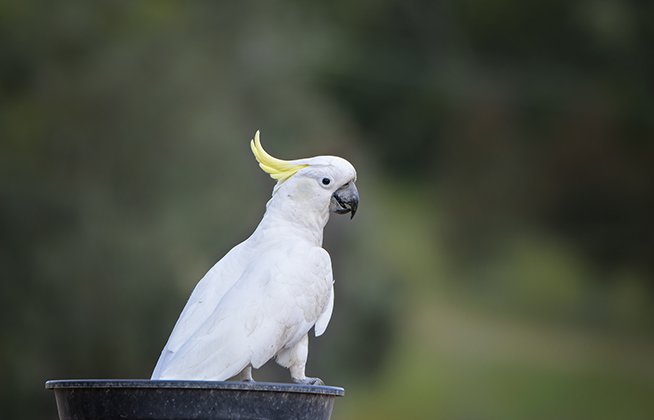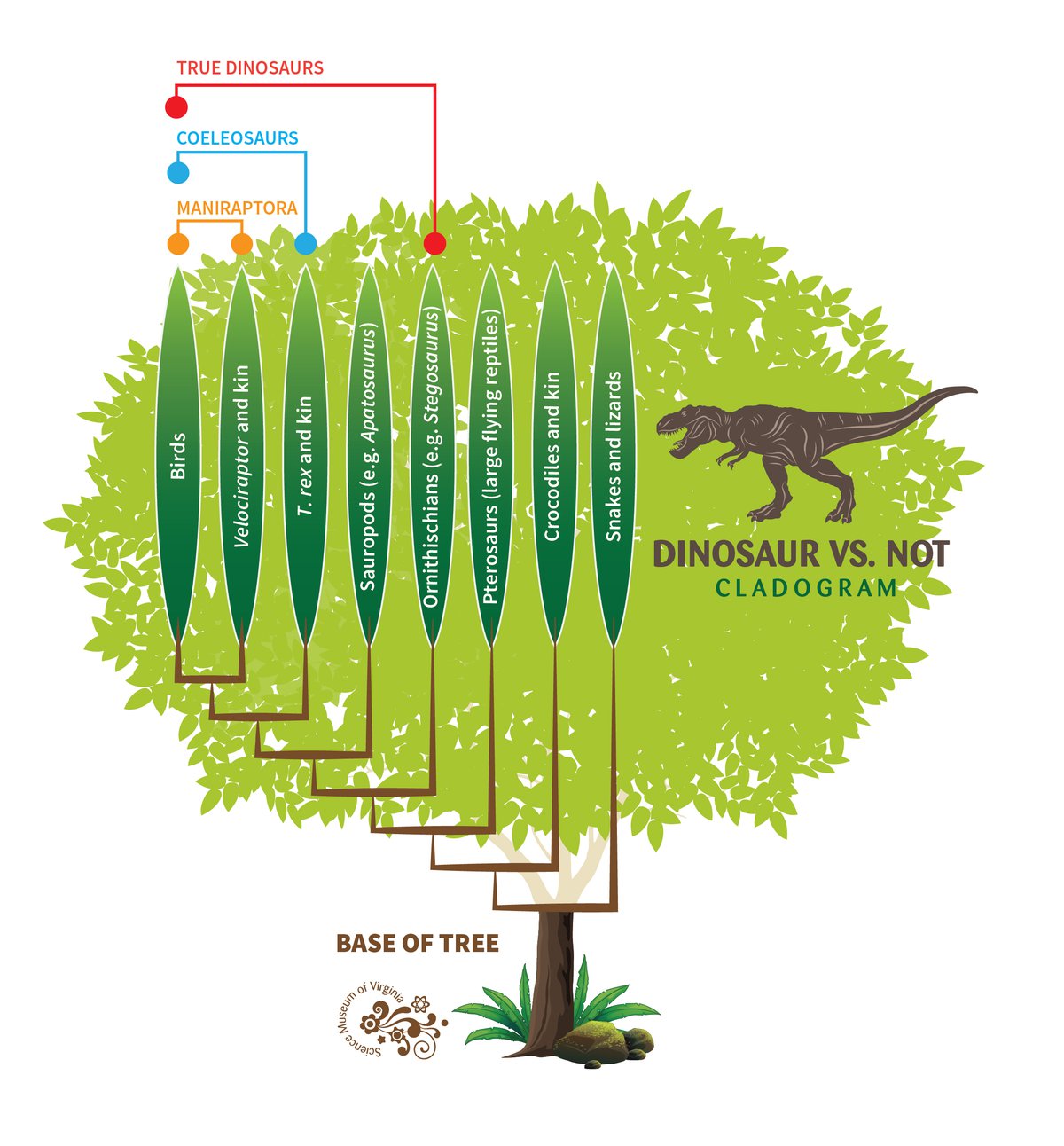On the surface, this seems like a simple question, right? Everyone knows what a dinosaur is … but do they?

If you ask someone what their favorite dinosaur is, they might mention T. rex as it is a very popular animal, but they also might mention a pterodactyl, Dimetrodon, plesiosaur, or even a hummingbird! Only one of those last four animals is actually a dinosaur. Do you know which one? (hint: it’s the tiny creature with feathers you might see flying in your yard!)
Just because something lived at the time of the dinosaurs (in the Mesozoic Era) doesn’t mean it’s a dinosaur! We live alongside many species, likes oaks, maples and dogwoods, but that doesn’t make us a tree! So, what is a dinosaur?
To a scientist, dinosaur has a very specific meaning. To understand that meaning, you need a (very) brief introduction to classifying living things.
Scientists group organisms together based on shared characteristics that reflect their evolutionary history. The more closely related two groups of organisms are, the more characteristics they will share and vice versa. Something to note: related in this case means that the organisms “share a common evolutionary ancestor,” not that they share aunts and uncles! To define these relationships, scientists look at many types of characters. They may compare the DNA sequences for living species and they may compare skeletal features for extinct organisms. This can be tricky as some traits are lost or modified over evolutionary time so the more data the better! Once they’ve gathered as much data as they can, scientists use it to generate a cladogram, what we might call a family tree. These trees help us visualize how closely or how distantly groups of organisms are related.

There’s one more thing about the characteristics that’s important to remember: groupings start out inclusive and get increasingly more exclusive. What does that mean? An example might be easier. For instance, all vertebrates belong to a shared group based on the characteristic of having a backbone. Vertebrates include mammals, fish, reptiles and amphibians. Mammals are a specific type of vertebrate: they all have backbones, but they have additional characteristics such as fur which is different from fish whose characters include scales and gills. So, all mammals are vertebrates, but not all vertebrates are mammals.
Ok, back to dinosaurs. When scientists define the term dinosaur, they are referring to a clade (group) of animals — the Dinosauria — that share a common evolutionary history based on a set of shared or modified characteristics that all dinosaurs have but that other animals do not. Let’s break down those characteristics.
Reptiles
- All dinosaurs are reptiles (and vertebrates), but not all reptiles are dinosaurs.
- Reptiles share a number of general characters including that they are amniotes (they lay eggs with an amnion, or give live birth with the same); they have scales; and they are diapsids. Diapsid means “two arches” and refers to a skull that has two holes posteriorly above and below the eye socket. This is an ancestral trait and is lost in many modern diapsids.
Archosaurs
- Dinosaurs are a type of reptile known as archosaurs, a group that includes crocodiles, pterosaurs and birds but excludes snakes and lizards, tuataras, and the extinct marine reptiles such as plesiosaurs and mosasaurs.
- Shared characteristics of archosaurs include teeth (if they have them) set in sockets; antorbital openings in the skull (openings in front of the eyes); mandibular openings in the jawbones; and a fourth trochanter, a specific ridge for attaching muscles on the femur. This character trait may have been key to the evolution of the dinosaurs.
Dinosaurs
- Dinosaurs have additional characteristics that make them unique amongst the archosaurs. They typically have an open acetabulum (hole or fenestra in the area where the femur meets the hip bone); an upright stance, meaning their hind legs are directly underneath their hips; an enlarged crest on their upper humerus (called the deltopectoral crest); and many have three or more fused sacral vertebrae (tail bones near the hips).
- Within the dinosaurs, of course, there are many different types from stegosaurs to tyrannosaurs.

So, are birds dinosaurs? Yes! Although the popular dinosaurs we think about are extinct, birds — which are a group of dinosaurs — are thriving with nearly 10,000 species alive today! Birds are a type of dinosaur just as dogs and bats are a type of mammal.
Paleontologists often refer to dinosaurs that were not in the direct line to birds as non-avian. Evolutionarily, birds are a specific group of dinosaurs that evolved in the Jurassic Period from a sub-group of carnivorous coelurosaurian dinosaurs called the maniraptora (“seizing hands”). Birds are the only living animals with feathers, but during the time of the dinosaurs, many of the coelurosaurian dinosaurs, as well as other maniraptorans such as Velociraptor and Deinonychus, had feathers at some point in their lives.
Some key characteristics shared between birds and their coelurosaurian/maniraptoran relatives include a semi-lunate carpal (a moon-shaped bone in the wrists allowing them to flex and grab prey); hollow, thin-walled bones; and a furcula (you probably know this as a wishbone).

It’s worth repeating that just because something lived at the time of the dinosaurs, it doesn’t mean it’s a dinosaur. Here are some animals that were not dinosaurs.
- Plesiosaurs, mosasaurs and ichthyosaurs are all marine animals that lived during the Mesozoic Era. The evolutionary relationships of these reptiles are still being discerned although all are definitely in the diapsid family tree. Mosasaurs seem to be nested within the lizard/snake family, although exactly where is up for debate. Plesiosaurs may be most closely related to turtles — who have their own outstanding evolutionary questions but seem to be migrating into the archosaur family (closer to dinosaurs than they are to other reptiles). Ichthyosaurs are diapsids, but their origins and relationships are still being studied.
- Pterosaurs are closely related to dinosaurs (they are archosaurian reptiles) but they do have some key differences from dinosaurs. They flew with a membranous wing that was attached to an elongated fourth finger and many were covered in a fur-like fuzz known as pycnofibers. They are an amazingly diverse group of reptiles. The Quetzalcoatlus had a 33-foot wingspan, about the size of a small Cessna airplane!
- Dimetrodon sp. are fascinating sail-backed animals that lived about 40 million years BEFORE the dinosaurs in the Permian Period (295 to 272 million years ago). They are not dinosaurs, although they are often labeled as such. These animals and their relatives belong to a group of animals called the synapsids (“single arch”) that includes modern mammals, meaning they are more closely related to mammals than dinosaurs! Rather than two temporal openings like the diapsids, their defining characteristic is only one opening behind each eye orbit.
Ultimately, living creatures are fascinating no matter what category they belong to so feel free to find pterodactyls pterrifc, Dimetrodon dear, plesiosaurs pleasing, and hummingbirds handsome! Just be in the know before you respond the next time someone asks about your favorite dinosaur!
Images courtesy of Getty Images.
